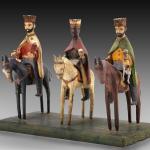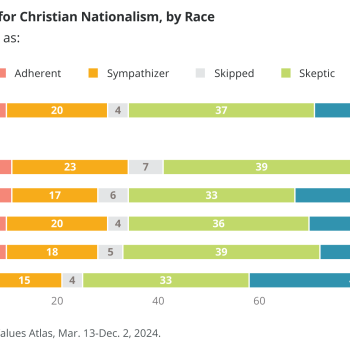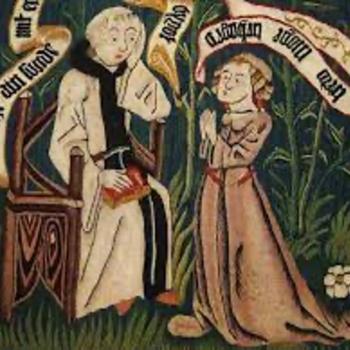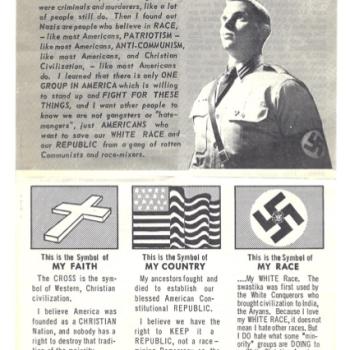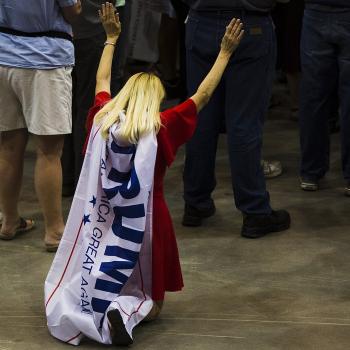Hi! I am a cultural sociologist on a tour of Texas Megachurches. Check out my first post here!
Megachurches are pretty influential in the culture of US evangelicalism, but their influences are often left out of landscape conversations about the state of religion in public life. Polling outfits, like PRRI, often rely on numbers provided by denominations to build their data sets. But megachurches, which are comprised of at least 2k attendees and bring in an average of 5 million dollars per year, are often non-denominational–so they are readily left off landscape analyses. Something like 10 million people will participate in megachurch services this coming weekend (given Hartford’s estimates of 1750 megachurches in the US with on average 5982 participants). What impacts are megachurches having in public life? What are their defining cultural characteristics? Is their cultural impact fairly construed as white christian nationalism? If so, how so?
Texas has more than its fair share of megachurches. San Antonio has seven in a 10 mile stretch of its city-encircling Loop 1604. At the time of my first post, I said I would tour five of these megachurches. Westover is the fifth church in this tour, my visits to Community Bible Church, Gateway Fellowship, Cornerstone Church, and Oak Hills are part of my Anxious Bench archive. By my count, in visiting these four churches, I have accounted for the Sunday morning experiences of close to sixty thousand churchgoers.
Back in July of 2023, when I first laid out the plans for this tour, I said I would be visiting megachurches to look for White Christian Nationalism. I wrote:
“When I read about Christian Nationalism, I get the impression an author imagines that authoritarian preachers create nationalist sensibilities in their hearers. I get the impression that such preachers harbor a dark version of charisma, able to turn their listeners into q-anon sympathizers.”
I said I would embark on this tour “with the eyes of a participant observer… looking for : a. the degree of race and gender diversity in their pews and on their stages, b. for the salience of charismatic influence in their worship styles and rhetoric, and c. for the way leaders may be playing any role in stoking authoritarianism and white supremacy.”
Here are my notes on Westover Hills (follow along with the online version of worship here).
In the run up to visiting Westover Hills Assembly of God, I went through its archive. This background research is how I found the sermon from 2018 that I covered in my previous installment. This July 4th sermon sounded very Christian Nationalist, especially in how it delineated the differences between what is legal (ie the Supreme Court) and what is truly moral (biblically-informed) and how it positioned its listeners as judges of public matters according to biblical standards. To do this work, the sermon advised Christians to: listen to God using their consciences and then use their votes to align the nation with what is moral, in a biblical sense. This sermon was unique, I think, for its practical delineation of how to do Christian Nationalism. You simply use your conscience to read the Bible and vote as much in accordance with it as possible.
This sermon was, I then noted, very Christian Nationalist, but could not be classified as White Christian Nationalist in any clear way. The morning’s key exemplar was Martin Luther King, Jr. Notably, in this sermon, founding pastor, now “Global Pastor” Jim Rion also proposed the Gettysburg Address as the true re-birth of the nation, that is, in 1863, while valorizing equality as America “regaining her soul;” all this landed in the year before the 1619 project. In admitting that the nation had, hitherto, been “lost” and disavowing 1776, this sermon was not what scholars have come to think of as Christian Nationalist.
This past Sunday, I visited looking for the racial and gender diversity of Westover’s pews and leadership and for authoritarian discourse. I also visited curious to listen for updated accounts of the Christian soul of the nation. Here is what I heard:
Worship. The service opened in a manner similar to the other megachurches covered in this series– with a charismatic praise and worship set. As was the case in all the other churches I visited, on this past Sunday, I walked into an auditorium that was darkened, with blue liquidy visuals on a large screen behind the singers that will also feature the words, so people can sing along. (What would happen if blue liquid visuals were not available?!) On the stage are a team of 6 worship leaders, four women and two men and all of appear them to be ethnically hispanic, except for one: Lindsey Calderón. This many hispanic people makes readier sense when one remembers that the city is 64% Hispanic. Calderón is a petite blonde woman standing center; the website shows she is the worship director but also married to the other director, David Calderón.
Now for those who might note that a hispanic woman can be blonde, of course, you would be correct. But if we are looking for the construction of white supremacy in megachurch practices, then the centering on the stage of a blonde person does a certain kind of work in constructing a racial hierarchy of whiteness. For our purposes then, for looking for racial and ethnic diversity and white supremacy, the composition of the “praise team” is mixed: the team is ethnically diverse and gender diverse, but it still centers whiteness in its blonde leader. Kate Bowler notes that megachurch pastor wives tend to present themselves as blondes; it’s worth asking why these aesthetic efforts “make sense” to women in this kind of leadership.
This auditorium is full and it seats 2200 people; it was constructed in 2014 following a three year building campaign. The worship set begins with “This is the Day,” by a group called Planetshakers, a Melbourne, Australia based worship collective whose songs are also sung by Cornerstone, John Hagee’s church some seven miles down the road. The band has performed worldwide and been nominated for several Dove awards, all this despite a controversy in which the church’s head pastor Michael Guglielmucci falsely claimed to be healed from cancer. He had been, it seems instead, “healed from a porn addiction.” Over at Christianity Today, various authors have been asking why these scandals don’t seem to drive people away from the music produced by such megachurches, but the reality is: no one singing Planetshakers or Hillsongs music thinks twice about Brian Houston, Carl Lentz, or Michael Guglielmucci. The music is what matters here; the pastors do not.
The following songs are lead by various members of the team. “1,000 Names” by Phil Wickham, which speaks of God as a Father and healer. Then, a young hispanic man, maybe 24 years old, leads an impressive rendition of “Who Else,” by Gateway Collective. This song features a chorus that describes God as:
“Lamb of God, Anointed One, who was and is to come,
Seated on the Throne Above
Righteous One who Shed his Blood
To prove to us the Father’s Love”
So far, so orthodox: no mention of flags or the nation. Next, another impressive vocalist– a young hispanic woman– leads “You’re Worthy of it All”, which features the line “day and night, night and day, let incense arise.” (20:00). The lines are taken from Revelation 5: 6-9. This song belongs to a tradition of post apocalyptic worship songs drawn from prophetic texts– like Kari Jobe’s 2003 smash hit, “Revelation Song.” (Jobe would later accept an invitation to visit Trump in the White House.) The young woman leading “Worthy of it All” did not only lead the song, vocally: she assumed full leadership of the congregation in call-and-response style.
It is easy to see how such a performance has been influenced by, for example, the Bethel Church version. (It’s worth a listen/view. Notice how much the the styling of the singers in the Bethel video matches that of the leaders at Westover: all in jeans, a very dressed down, while highly emotional, leadership approach. These 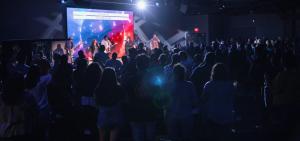 congruences– across the nation –suggest how established worship cultures are within charismatic and evangelical church networks.) The same young woman closes the worship section with Israel Houghton’s “Alpha and Omega” (25:30). This is the peak of the worship service this morning– between minutes 26 and 28. If you are looking for the charismatic salience of this service, this is it– and just as in our visit to Cornerstone, it turns out that the emotional peak of the megachurch worship is one defined by black church musical sensibilities. I ask myself whether a mainline church could pull this moment off– singing a black church song, in full voice. Somehow I doubt it. I would here note that charismatic megachurches like Cornerstone and Westover can credibly draw from American Pentecostalism’s long engagement with Black church practices. If, as Robert P. Jones notes, American Christianity was White Too Long–if, as he says, its race biases and impacts are a function of its “legacy”– it is worth noting that many charismatic megachurches don’t have the long, overtly racist histories that Jones demonstrates that many denominations do.
congruences– across the nation –suggest how established worship cultures are within charismatic and evangelical church networks.) The same young woman closes the worship section with Israel Houghton’s “Alpha and Omega” (25:30). This is the peak of the worship service this morning– between minutes 26 and 28. If you are looking for the charismatic salience of this service, this is it– and just as in our visit to Cornerstone, it turns out that the emotional peak of the megachurch worship is one defined by black church musical sensibilities. I ask myself whether a mainline church could pull this moment off– singing a black church song, in full voice. Somehow I doubt it. I would here note that charismatic megachurches like Cornerstone and Westover can credibly draw from American Pentecostalism’s long engagement with Black church practices. If, as Robert P. Jones notes, American Christianity was White Too Long–if, as he says, its race biases and impacts are a function of its “legacy”– it is worth noting that many charismatic megachurches don’t have the long, overtly racist histories that Jones demonstrates that many denominations do.
It would be misleading for me to treat this part, the worship, as the run-up to the preaching, which might somehow be more important. Instead, in charismatic worship services, the worship edges out the preaching. Westover provides very- good- to- excellent worship, with a band that can be relied on to produce the worship songs that have come to define our era by the force of popular choice. This is all important; no megachurch could survive without it.
Preaching. How might the preaching complement the force of such worship? The sermon is delivered by Pastor Jonathan Mussett, who is married to Pastor Danae (née Rion) Mussett; they truly occupy the senior role together. Her title says, “Women’s Pastor” but it is best not to read this too literally: Danae Mussett is the founding pastor’s daughter. There is no pulpit at Westover for Jonathan Mussett outside of his marriage to Danae. Like Kate Middleton in Kensington Palace, like Tom Wombsgams on HBO’s Succession, and like Jared Kushner, Jonathan Mussett has proven himself over the course of the last twenty years to be faithful and steady in his role as support pastor to the founding pastor, Jim Rion, and a faithful husband and father. These are the qualities really needed to help what is now an operation worth more than $25 million. And these are not easy qualities to find: the church has seen more than one supporting pastor leave under tense circumstances. In 2018, Leah Payne and I co-authored a piece for The Washington Post, suggesting that evangelicals’ embrace of Trump was in part based on myriad shared affinities (we noted then their love for celebrity culture and embrace of Zionism). Here emerges another affinity: Westover Hills and Cornerstone Church are both powered by family systems built on loyalty. Donald Trump’s White House and current campaign also feature his family as trustworthy and loyal powerbrokers. In Jonathan and Danae Mussett, Westover has placed its hopes for long term stability.

Accordingly, Pastor Jonathan Mussett is not the fiery, apocalyptic preacher that his father-in-law was in his younger years. His background in marriage and family therapy allows him to speak, at length, and with some real insights into, nurturing family relationships. Today’s sermon uses Luke 2:46-47 to present Jesus as “the master communicator,” who is found in the temple, seated, listening to elders, and only then asks questions. Pastor Jonathan extrapolates that this is a great way for husbands to relate to their wives and for parents to relate to their children. The frame is the heteronormative family. He admonishes that the Holy Spirit can speak to listeners about how to respond to someone and how not to respond. The sermon renders Jesus’ adolescent temple visit a map for domestic relationships– maybe even the workplace. But it mentions nothing about Israel, nothing about Palestine, nothing about an upcoming election. The entire vision of the sermon is for peaceable and stable family relations; no obvious white Christian nationalism here. If we are looking for Christian Nationalist content, it’s not here.
What this domestic emphasis does produce is a First Family, and for our purposes, while the church is diverse and the platform features women and men leaders, most of them from ethnically diverse groups, whiteness and a white family remain central in the church’s spiritual and political economy. So as regards our point c. the way leaders may be playing any role in stoking authoritarianism and white supremacy– my answer here would have to be a bit tricky. There is a form of authoritarianism here and there is white supremacy in racial hierarchies, but such parlays and constructions of power are soft. They are swaddled in family relations and family feelings that promote the acceptance of White Christian patriarchs. This is an awkward observation to make, I think, given all the racial and gender diversity in the leadership, and please note: Westover Hills has *so many women* in leadership on its board and staff (scroll down). It is also part of the Assemblies of God, which ordained the most women of any denomination in 2021, but I submit that when all these women are married or related to the men in power, the system of patriarchy is ultimately upheld. So while the worship threatens to be very interracial and empowering, the preaching and organization of power at the top of the structural hierarchy reinstate white (patriarchal) supremacy.


